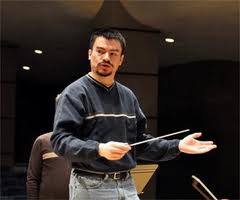|
Symphony
FROM THE NEW WORLD TO THE OLD WORLD
by Peter Lert
Saturday, June 14, 2025
Chamber
MC2 DUO RECITAL CLOSES 222'S SEASON
by Terry McNeill
Saturday, June 14, 2025
Choral and Vocal
CANTIAMO SONOMA'S LUSCIOUS A CAPELLA SINGING IN SEASON ENDING CONCERT
by Pamela Hicks Gailey
Sunday, June 8, 2025
Symphony
SRS SEASON ENDS WITH RESOUNDING TA-TA-TA-BANG
by Terry McNeill
Sunday, June 1, 2025
Symphony
YOUTHFUL VIRTUOSITY ON DISPLAY AT USO'S MAY CONCERTS
by Peter Lert
Saturday, May 17, 2025
Symphony
MYSTICAL PLANETS AND LIVELY GERSHWIN ORTIZ AT FINAL SRS CONCERT
by Peter Lert
Sunday, May 4, 2025
Symphony
VSO'S CONCERT MUSIC OF TIME, MUSIC OF PLACE
by Peter Lert
Sunday, April 27, 2025
VOCAL ELEGANCE AND FIRE AT THE 222'S RECITAL APRIL 26
by Pamela Hicks Gailey
Saturday, April 26, 2025
CANTIAMO SONOMA SINGS AN INSPIRED GOOD FRIDAY MOZART REQUIEM CONCERT
by Pamela Hicks Gailey
Friday, April 18, 2025
DRAMATIC SHOSTAKOVICH SYMPHONY CLOSES PHILHARMONIC'S 25TH SEASON
by Terry McNeill
Sunday, April 13, 2025
|
 |
 Norman Gamboa |
RUSSIAN ROMANTIC WORKS HIGHLIGHT APSC CONCERT
by Terry McNeill
Saturday, February 23, 2013
Luxurious orchestration has always been a hallmark of Russian symphonic music, as was evident in the works of Liadov, Tchaikovsky and Shostakovich performed by the American Philharmonic Sonoma County (APSC) at the Santa Rosa High School Performing Arts Hall on Feb. 23.
Guest conductor Mark Wardlaw led a novel work to begin the concert, Liadov’s "Eight Russian Folk Songs," Op. 58. This well-balanced suite from 1906 showcased many sections of the orchestra, with bassoonist Steve Peterson and principal cellist Margaret Moores giving extended solos. Mr. Wardlaw carefully matched the string sections in the third folk song, "Plaintive," where the theme was successively handed from the cellos to the first violins and finally to the second violins and basses. The fifth song, "Legend of the Birds," was taken as a sad lament, with the strings playing an eerie shimmer at the end. The performance made these abbreviated and pithy songs sound greater than the sum of their parts.
Closing the first half was Tchaikovsky’s charming "Rococo Variations for Cello and Orchestra," Op. 33, with Ann Suda playing the solo part. Working with a reduced ensemble, Mr. Wardlaw helped craft a rich sonic tapestry for the cellist in this Mozartian work from 1877. The hall, at least from the lower orchestral seats, seems to favor low frequencies, and Ms. Suda’s instrument projected with substantial resonance. Early in the work her tone at the top had a dry edge, but it broadened throughout the rest of the seven variations. The delightful top-to-bottom slides on the fingerboard were impeccable, and in the cadenza Ms. Suda never hurried, letting the long pauses add suspense to the music. She clearly identified with the subtle and non-heroic interplay of cello and orchestra.
During the Tchaikovsky, Debra Scheuerman and Emily Reynolds played a scintillating flute duet, and hornist Randall Masselink performed chaste solo parts. In the fast finale with swirling, almost breakneck, interplay between cello and orchestra, Mr. Wardlaw kept the musicians from running off the rails, and the applause from 600 in the hall was long and loud.
Following intermission, Shostakovich’s effervescent E-Flat Major Ninth Symphony, Op. 70, completed the program. There was a time when a Shostakovich symphony would have been a tough challenge for the APSC because the orchestra lacked instrumental depth in the high strings and winds. That has changed.
Mr. Wardlaw introduced the Shostakovich symphony with a verbal description of the work’s genesis and the situation in the Soviet Union at the end of the "Great Patriotic War." All through the performance, the orchestra executed the familiar Shostakovich sonic landmarks: virtuoso wind playing, brilliant string sonics in the highest range, banal themes resolving into cogent and stirring marches, and always masterful orchestration. In the Moderato, the clarinet and oboe solos by Nicholas Xenelis and Chris Krive, respectively, were opulent. Described by the conductor as a horse race, the Presto movement was exciting and everywhere under control. Tom Hyde’s trumpet solo was beautiful, as was Ms. Reynolds's sparkling piccolo work.
Mr. Wardlaw highlighted Shostakovich's commanding sense of orchestral color and dynamics, and the performance brought the audience to its feet after the roaring finale. It was lighter than usual Shostakovich, but no less impressive. With this third concert in its new home, the APSC has developed a warm familiarity with the solid acoustics of the refurbished auditorium.
|
